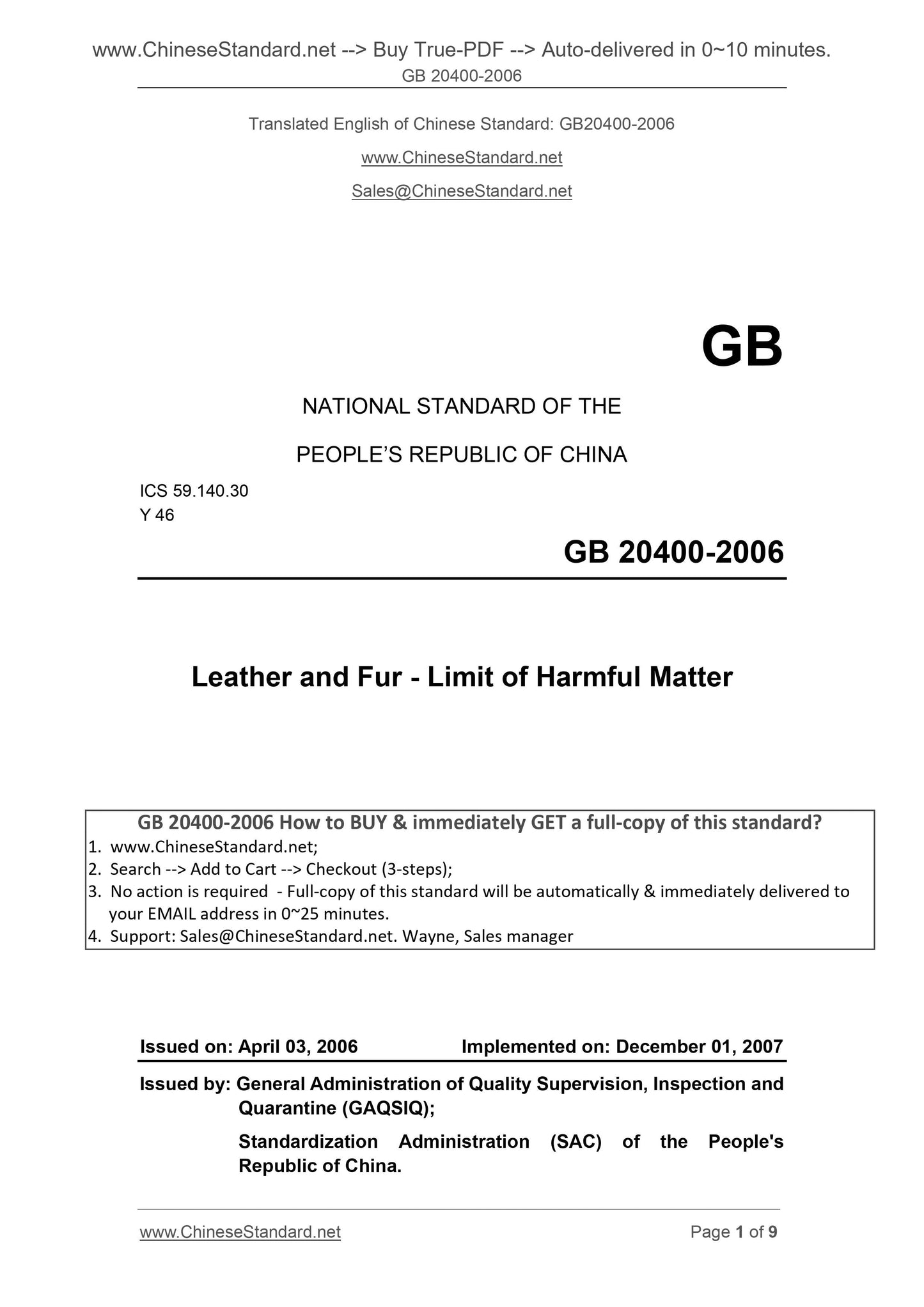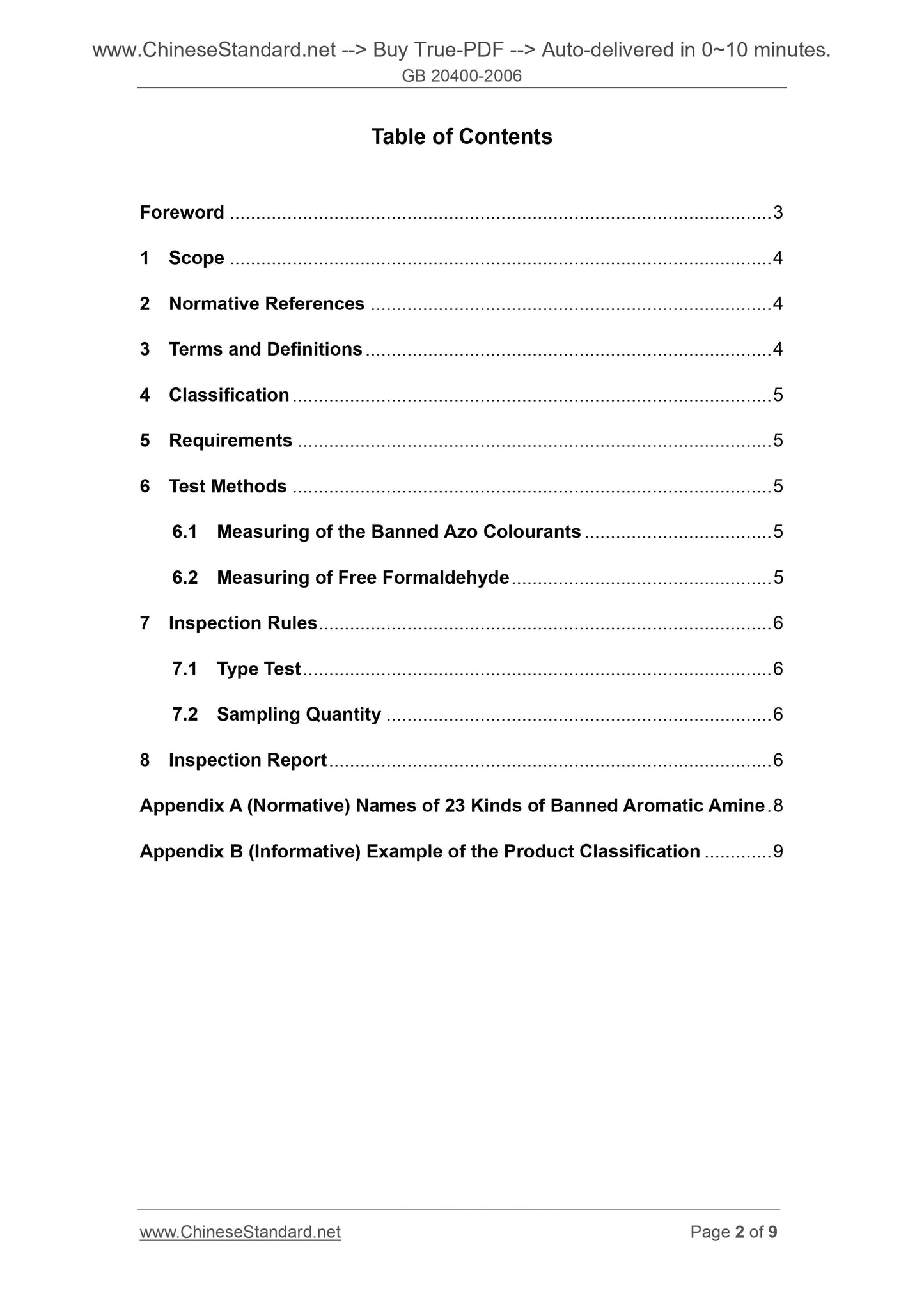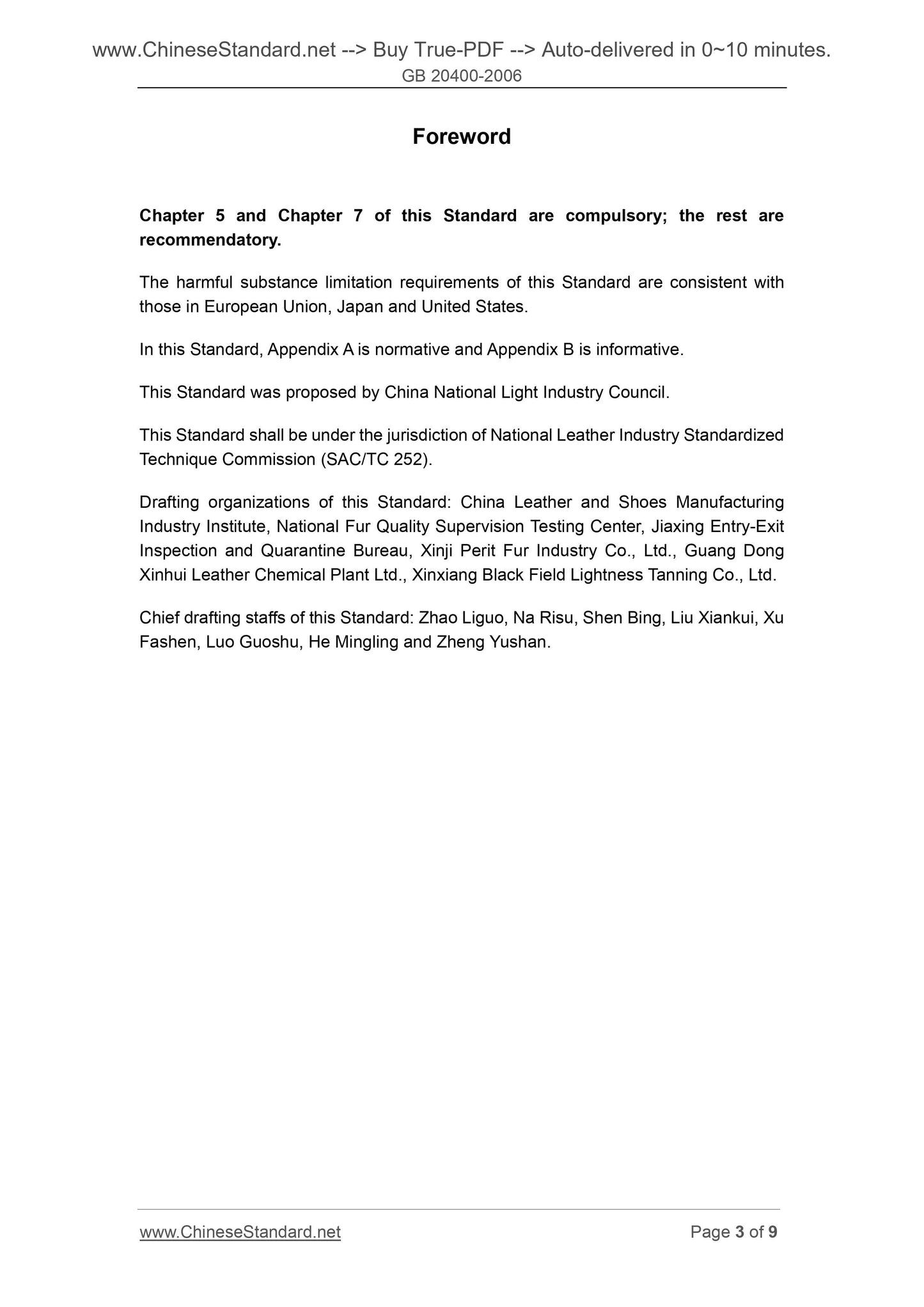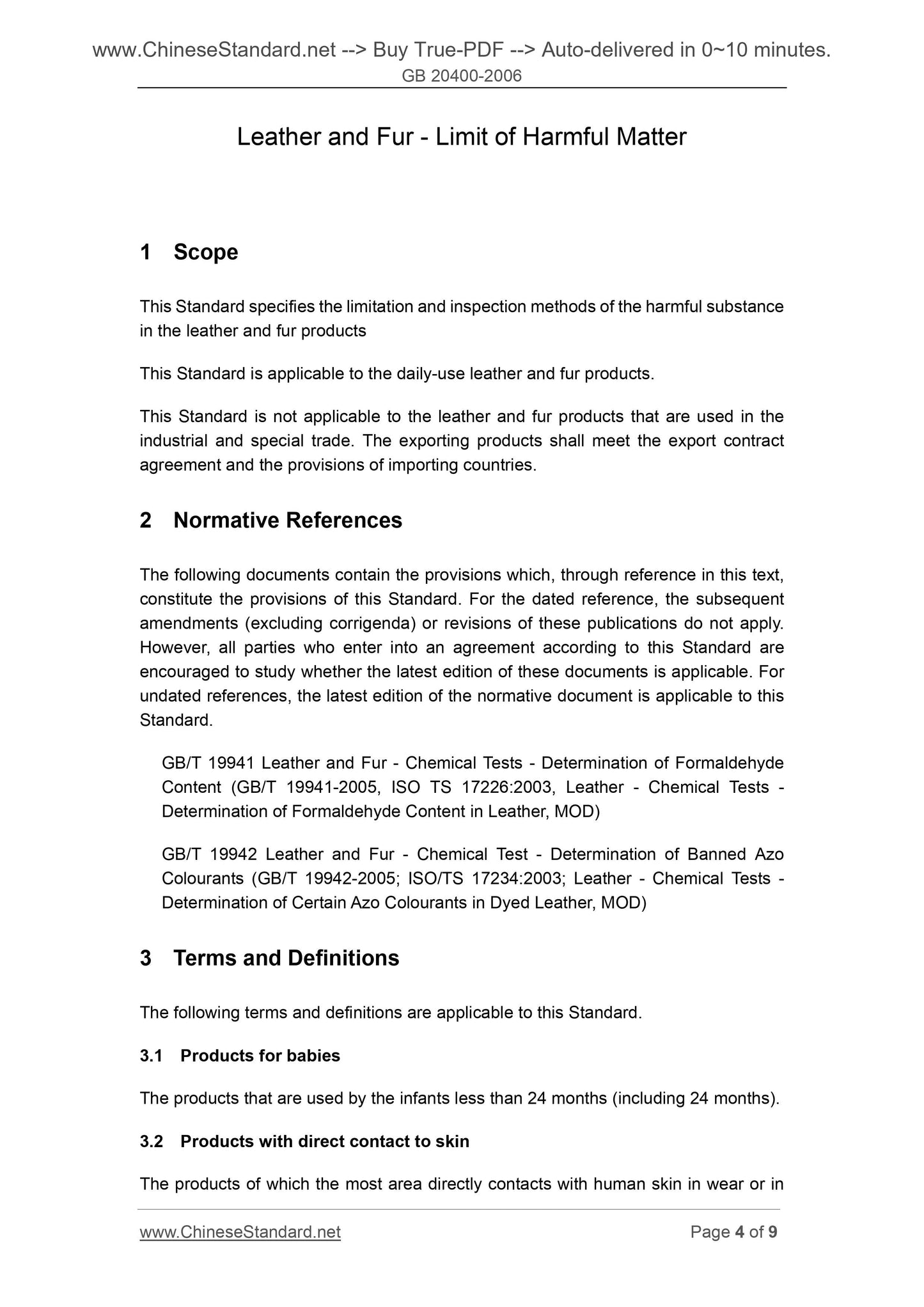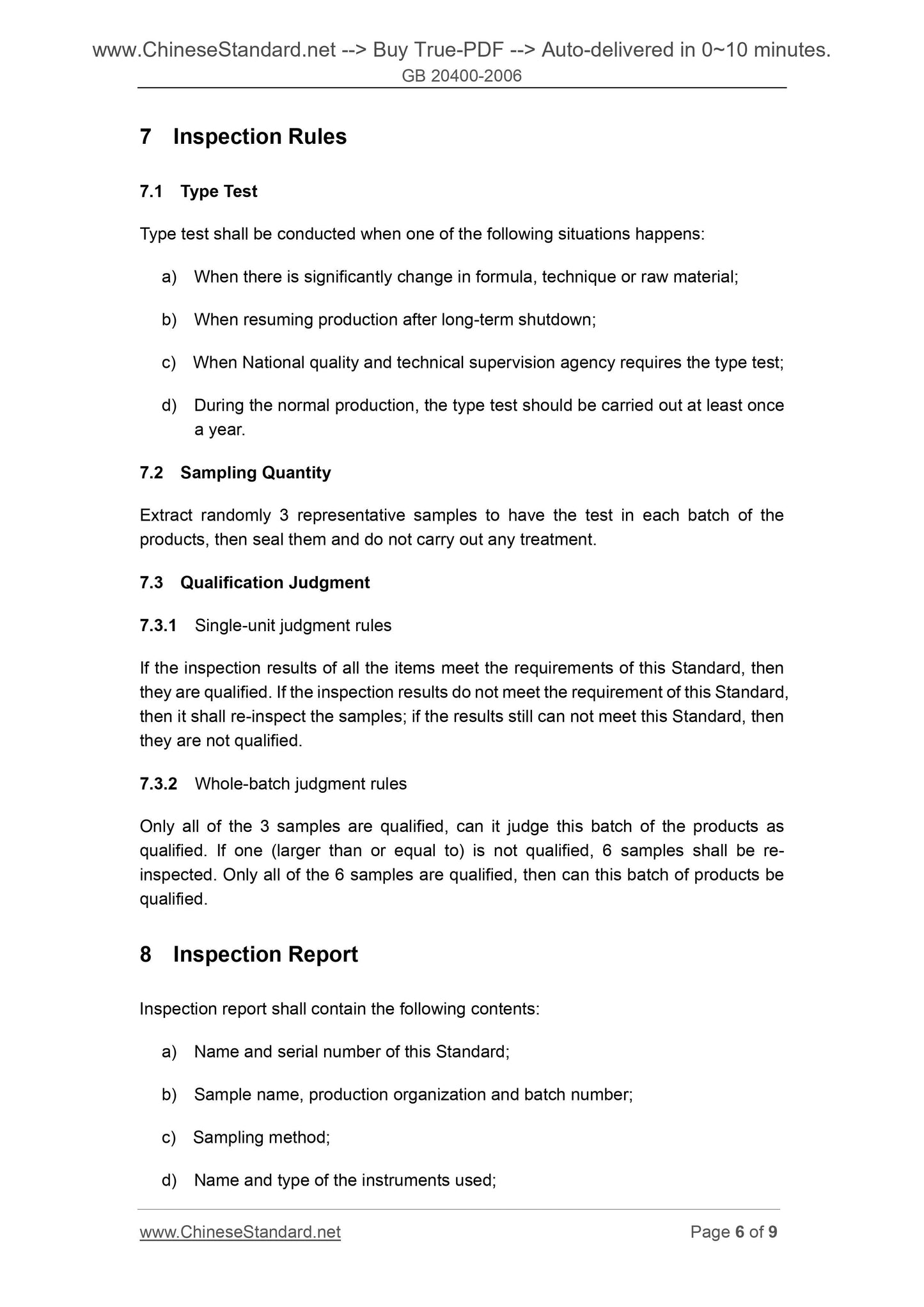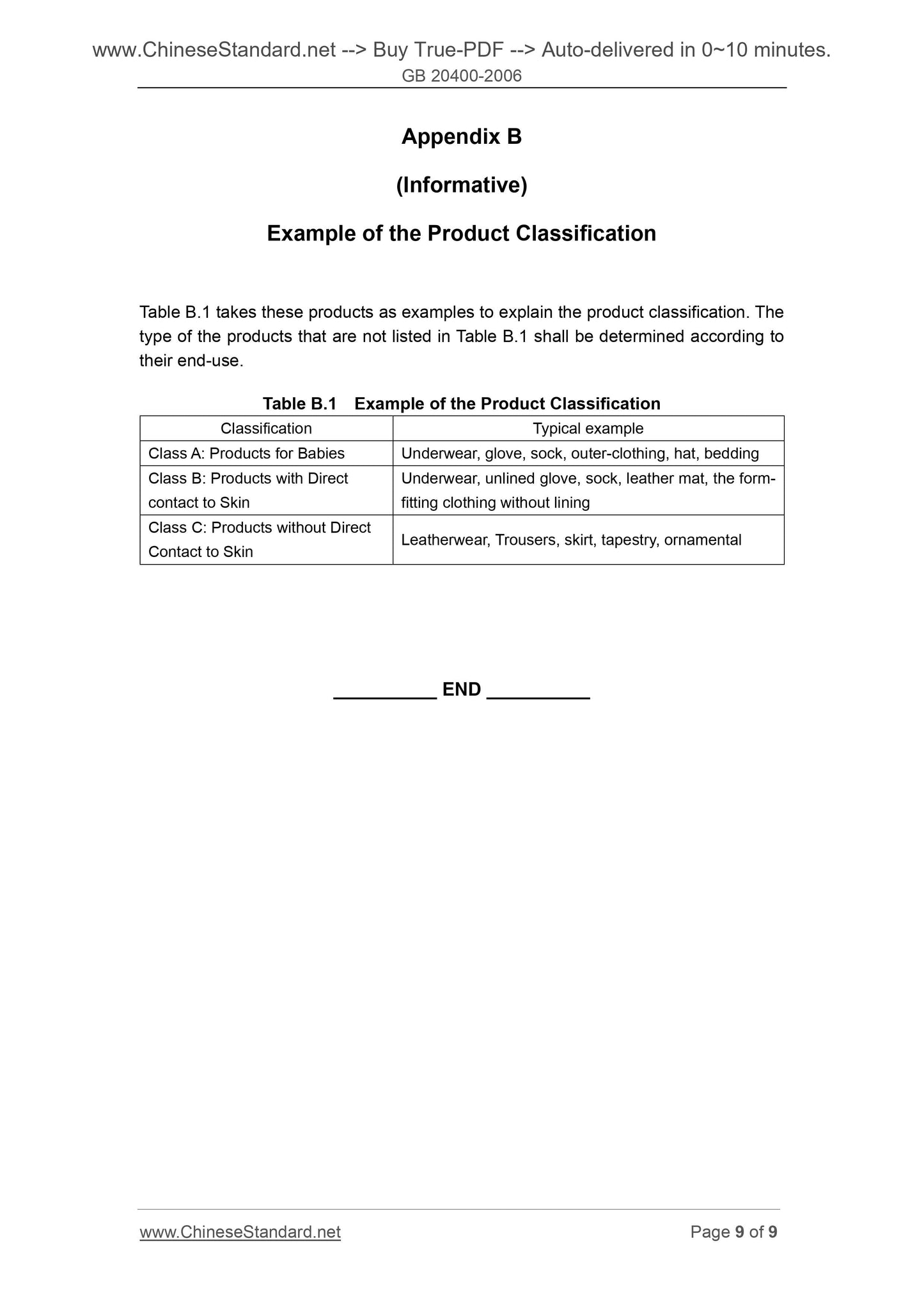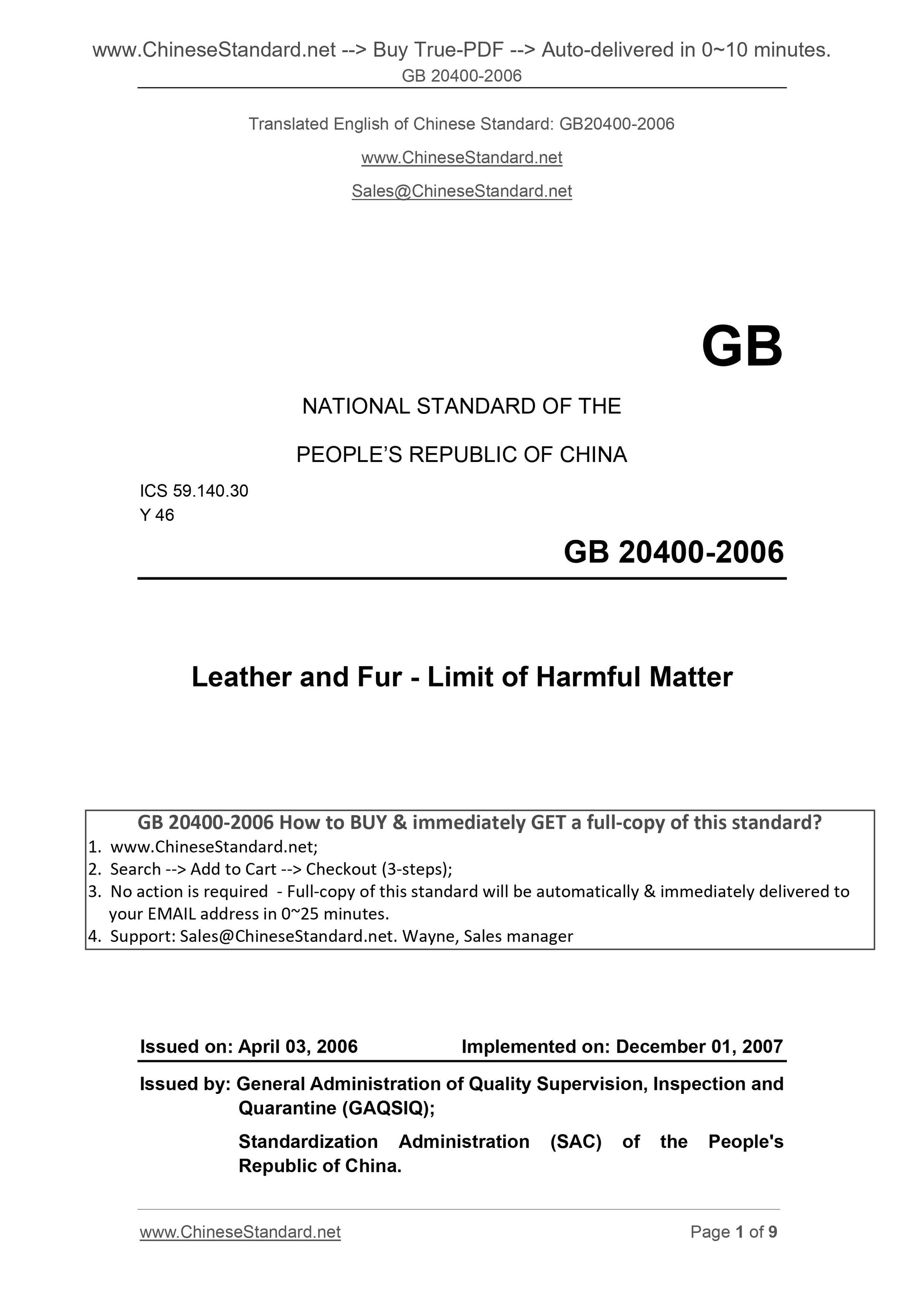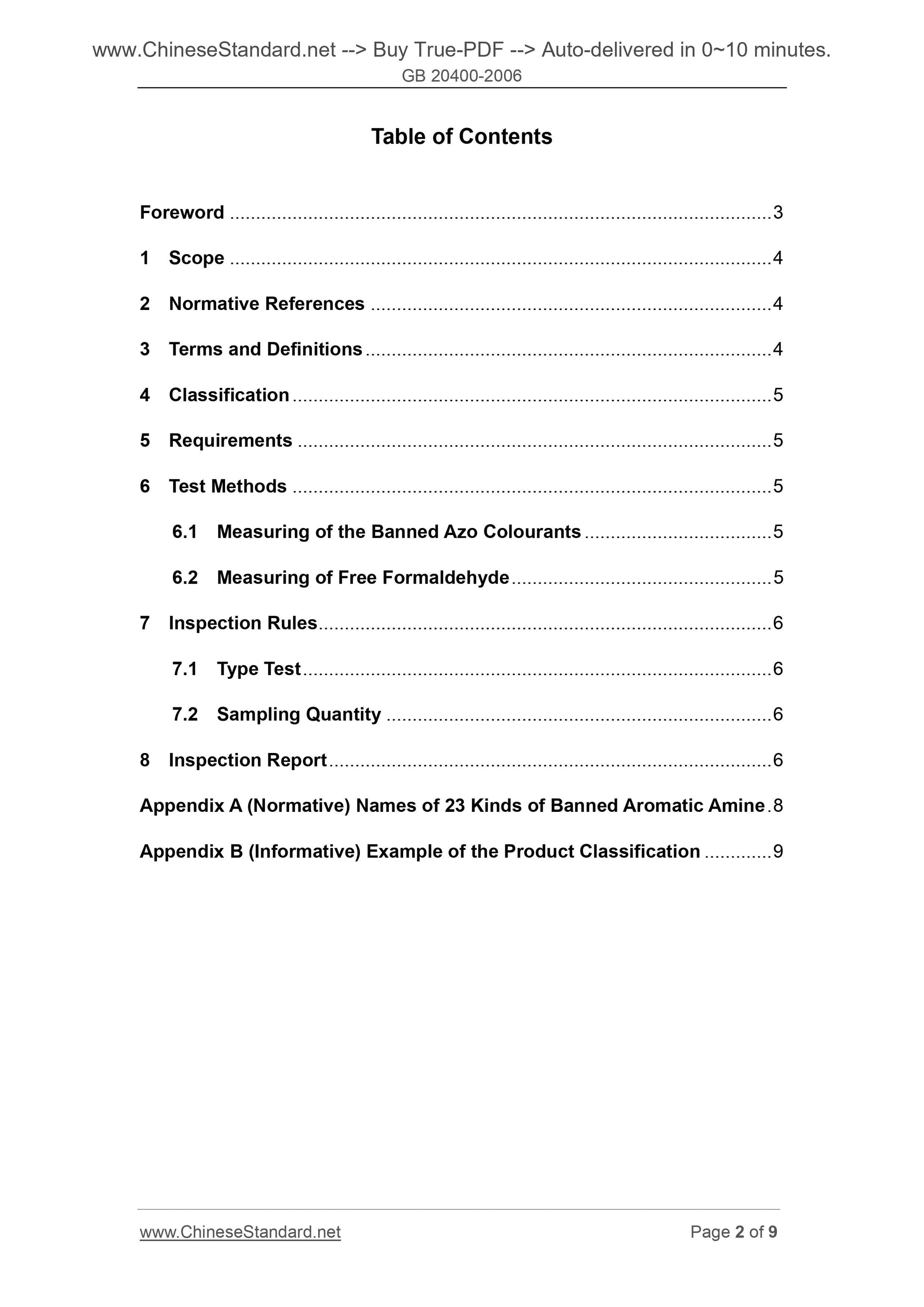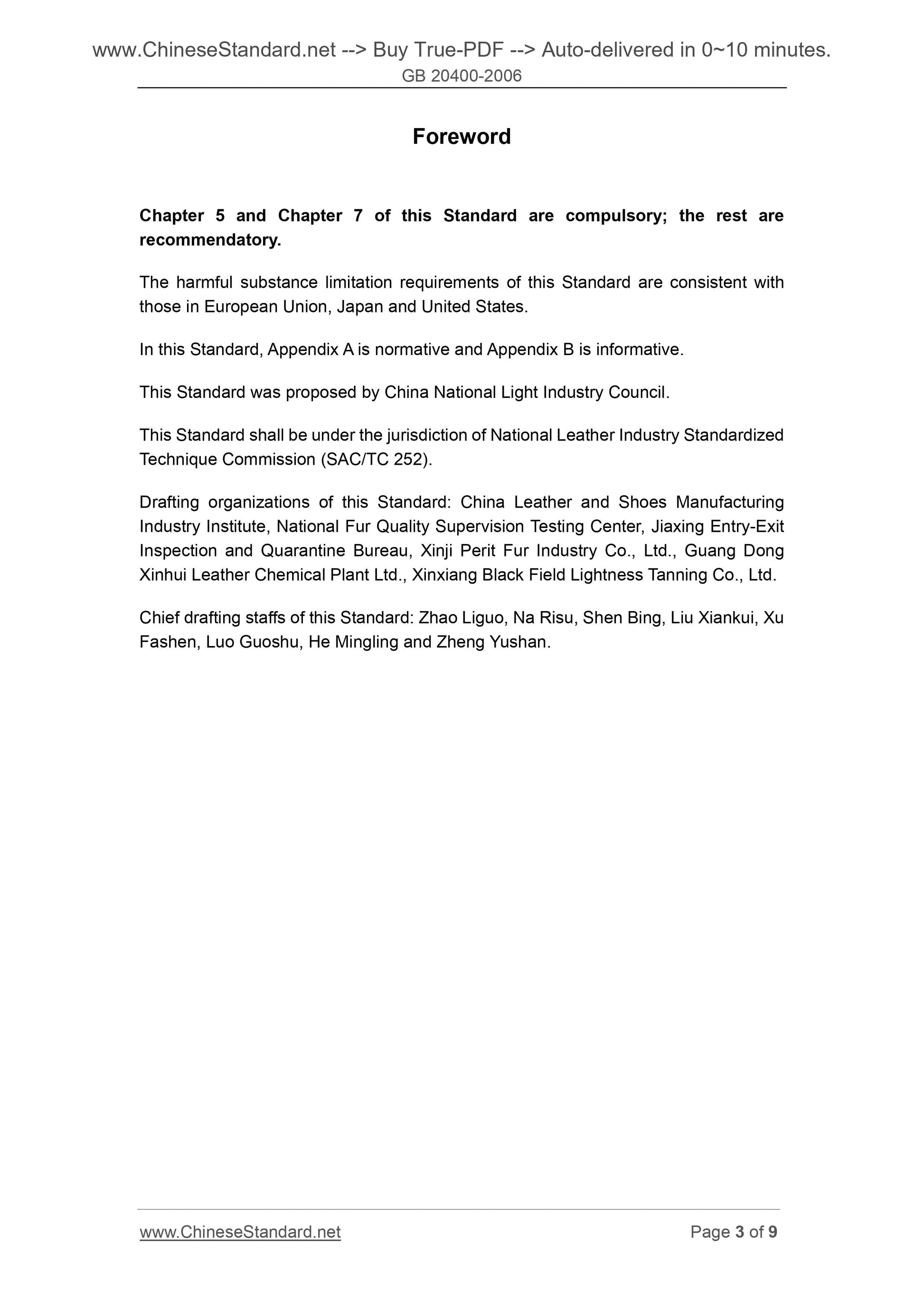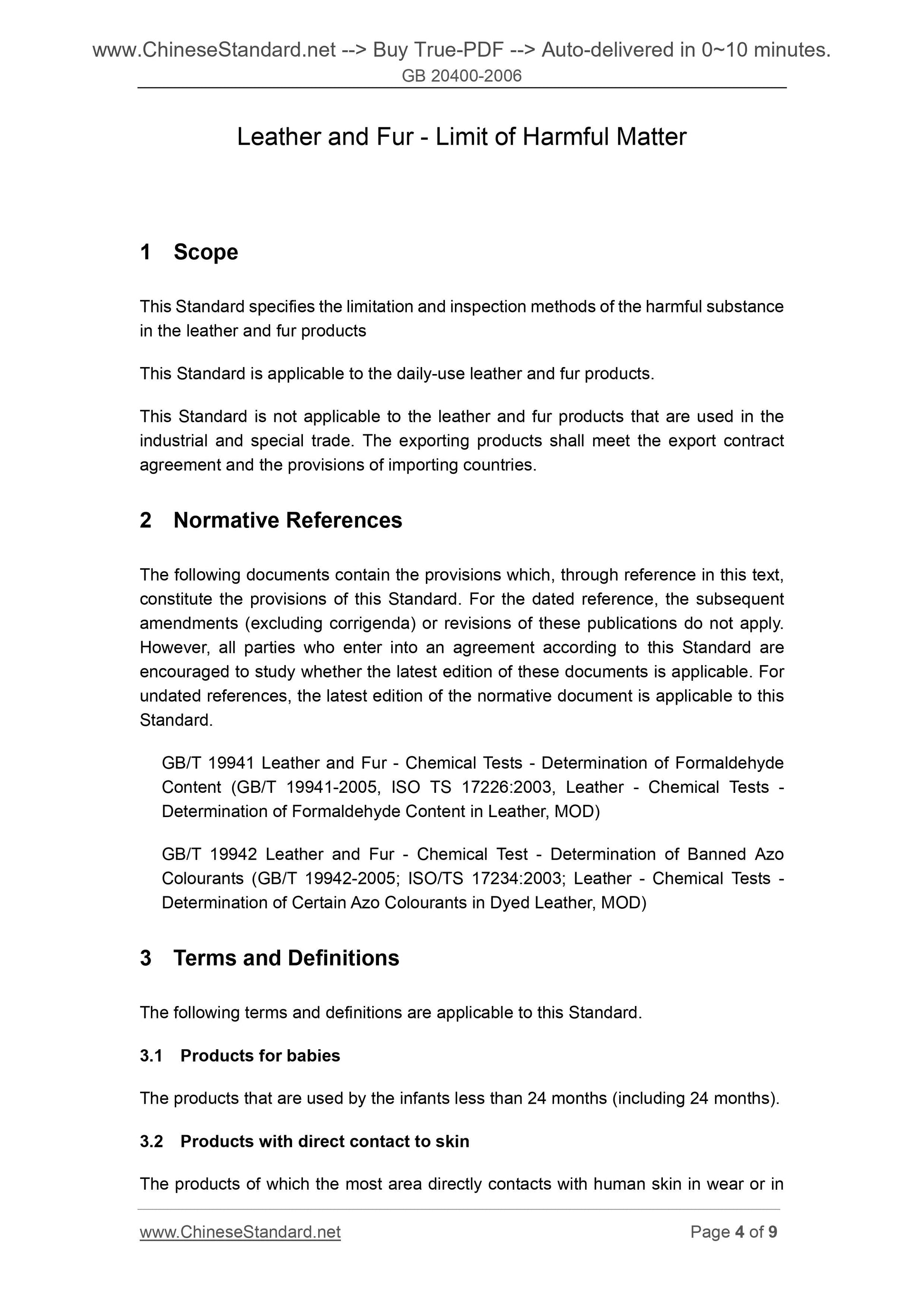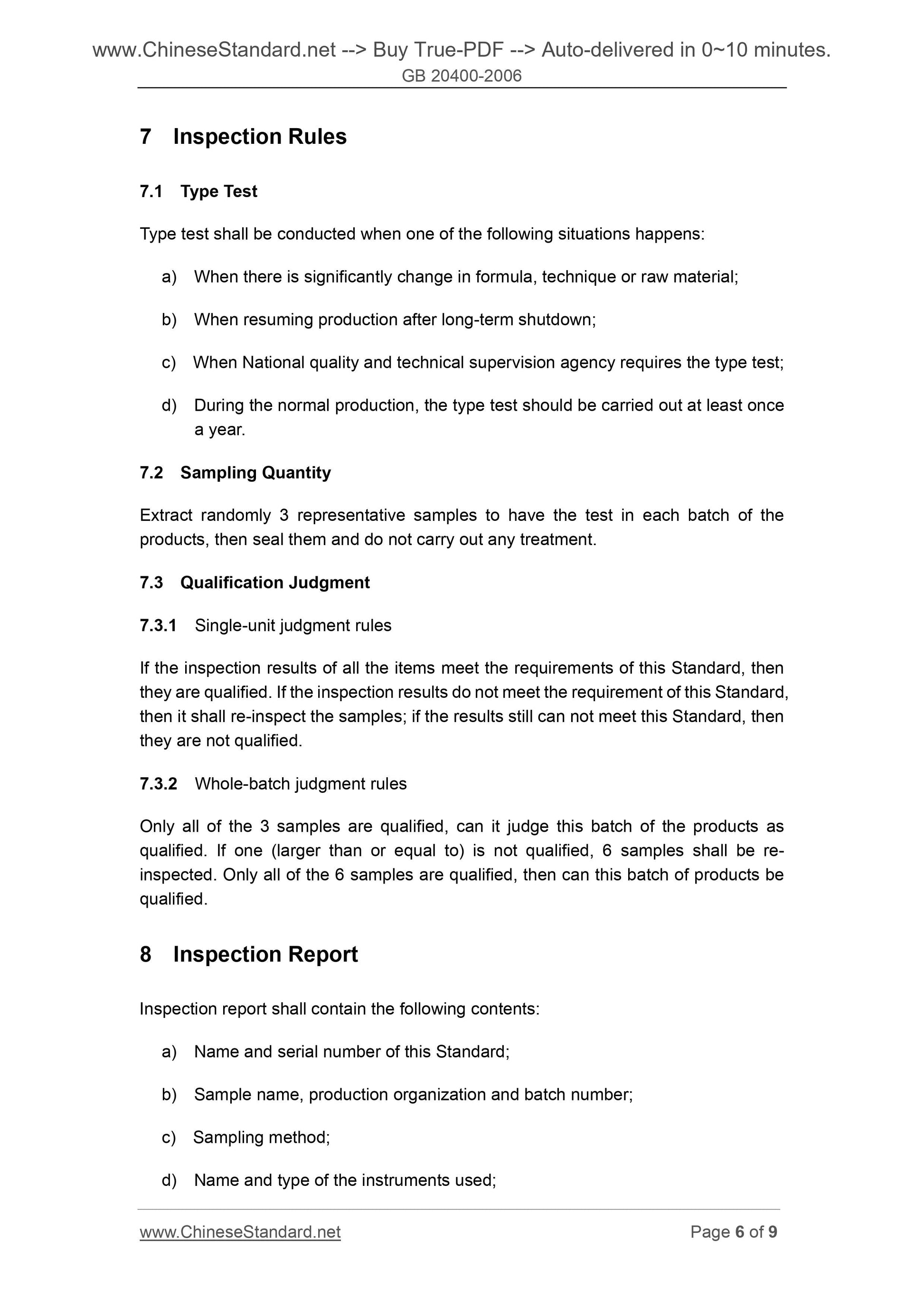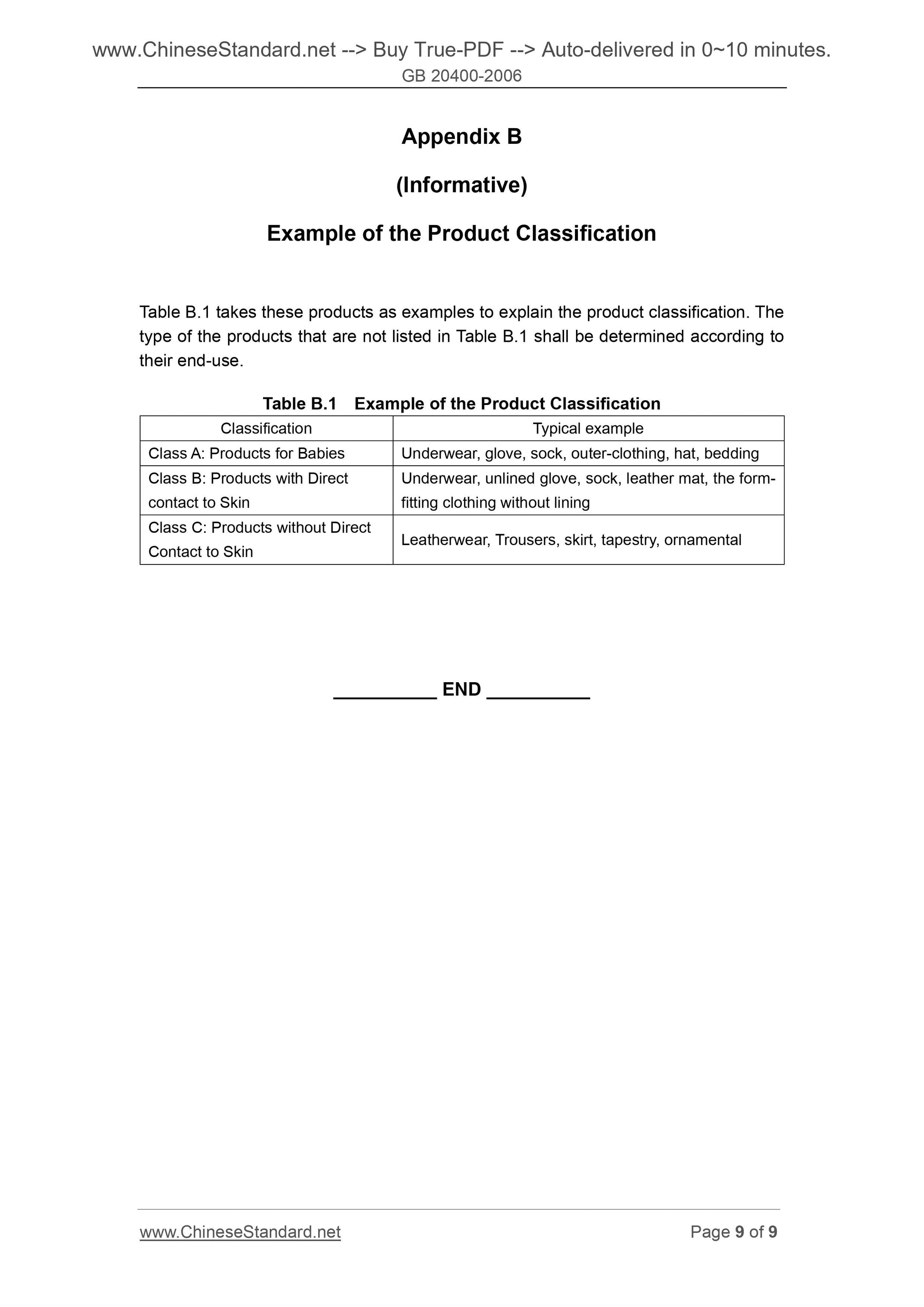1
/
of
6
PayPal, credit cards. Download editable-PDF & invoice in 1 second!
GB 20400-2006 English PDF
GB 20400-2006 English PDF
Regular price
$70.00
Regular price
Sale price
$70.00
Unit price
/
per
Shipping calculated at checkout.
Couldn't load pickup availability
GB 20400-2006: Leather and fur -- Limit of harmful matter
Delivery: 9 seconds. Download (& Email) true-PDF + Invoice.
Get Quotation: Click GB 20400-2006 (Self-service in 1-minute)
Historical versions (Master-website): GB 20400-2006
Preview True-PDF (Reload/Scroll-down if blank)
GB 20400-2006
GB
NATIONAL STANDARD OF THE
PEOPLE’S REPUBLIC OF CHINA
ICS 59.140.30
Y 46
Leather and Fur - Limit of Harmful Matter
ISSUED ON. APRIL 03, 2006
IMPLEMENTED ON. DECEMBER 01, 2007
Issued by. General Administration of Quality Supervision, Inspection and
Quarantine (GAQSIQ);
Standardization Administration (SAC) of the People's
Republic of China.
Table of Contents
Foreword ... 3
1 Scope ... 4
2 Normative References ... 4
3 Terms and Definitions ... 4
4 Classification ... 5
5 Requirements ... 5
6 Test Methods ... 5
6.1 Measuring of the Banned Azo Colourants ... 5
6.2 Measuring of Free Formaldehyde ... 5
7 Inspection Rules ... 6
7.1 Type Test ... 6
7.2 Sampling Quantity ... 6
8 Inspection Report ... 6
Appendix A (Normative) Names of 23 Kinds of Banned Aromatic Amine . 8
Appendix B (Informative) Example of the Product Classification ... 9
Foreword
Chapter 5 and Chapter 7 of this Standard are compulsory; the rest are
recommendatory.
The harmful substance limitation requirements of this Standard are consistent with
those in European Union, Japan and United States.
In this Standard, Appendix A is normative and Appendix B is informative.
This Standard was proposed by China National Light Industry Council.
This Standard shall be under the jurisdiction of National Leather Industry Standardized
Technique Commission (SAC/TC 252).
Drafting organizations of this Standard. China Leather and Shoes Manufacturing
Industry Institute, National Fur Quality Supervision Testing Center, Jiaxing Entry-Exit
Inspection and Quarantine Bureau, Xinji Perit Fur Industry Co., Ltd., Guang Dong
Xinhui Leather Chemical Plant Ltd., Xinxiang Black Field Lightness Tanning Co., Ltd.
Chief drafting staffs of this Standard. Zhao Liguo, Na Risu, Shen Bing, Liu Xiankui, Xu
Fashen, Luo Guoshu, He Mingling and Zheng Yushan.
Leather and Fur - Limit of Harmful Matter
1 Scope
This Standard specifies the limitation and inspection methods of the harmful substance
in the leather and fur products
This Standard is applicable to the daily-use leather and fur products.
This Standard is not applicable to the leather and fur products that are used in the
industrial and special trade. The exporting products shall meet the export contract
agreement and the provisions of importing countries.
2 Normative References
The following documents contain the provisions which, through reference in this text,
constitute the provisions of this Standard. For the dated reference, the subsequent
amendments (excluding corrigenda) or revisions of these publications do not apply.
However, all parties who enter into an agreement according to this Standard are
encouraged to study whether the latest edition of these documents is applicable. For
undated references, the latest edition of the normative document is applicable to this
Standard.
GB/T 19941 Leather and Fur - Chemical Tests - Determination of Formaldehyde
Content (GB/T 19941-2005, ISO TS 17226.2003, Leather - Chemical Tests -
Determination of Formaldehyde Content in Leather, MOD)
GB/T 19942 Leather and Fur - Chemical Test - Determination of Banned Azo
Colourants (GB/T 19942-2005; ISO/TS 17234.2003; Leather - Chemical Tests -
Determination of Certain Azo Colourants in Dyed Leather, MOD)
3 Terms and Definitions
The following terms and definitions are applicable to this Standard.
3.1 Products for babies
The products that are used by the infants less than 24 months (including 24 months).
3.2 Products with direct contact to skin
The products of which the most area directly contacts with human skin in wear or in
7 Inspection Rules
7.1 Type Test
Type test shall be conducted when one of the following situations happens.
a) When there is significantly change in formula, technique or raw material;
b) When resuming production after long-term shutdown;
c) When National quality and technical supervision agency requires the type test;
d) During the normal production, the type test should be carried out at least once
a year.
7.2 Sampling Quantity
Extract randomly 3 representative samples to have the test in each batch of the
products, then seal them and do not carry out any treatment.
7.3 Qualification Judgment
7.3.1 Single-unit judgment rules
If the inspection results of all the items meet the requirements of this Standard, then
they are qualified. If the inspection results do not meet the requirement of this Standard,
then it shall re-inspect the samples; if the results still can not meet this Standard, then
they are not qualified.
7.3.2 Whole-batch judgment rules
Only all of the 3 samples are qualified, can it judge this batch of the products as
qualified. If one (larger than or equal to) is not qualified, 6 samples shall be re-
inspected. Only all of the 6 samples are qualified, then can this batch of products be
qualified.
8 Inspection Report
Inspection report shall contain the following contents.
a) Name and serial number of this Standard;
b) Sample name, production organization and batch number;
c) Sampling method;
d) Name and type of the instruments used;
Appendix B
(Informative)
Example of the Product Classification
Table B.1 takes these products as examples to explain the product classification. The
type of the products that are not listed in Table B.1 shall be determined according to
their end-use.
Table B.1 Example of the Product Classification
Classification Typical example
Class A. Products for Babies Underwear, glove, sock, outer-clothing, hat, bedding
Class B. Products with Direct
contact to Skin
Underwear, unlined glove, sock, leather mat, the form-
fitting clothing without lining
Class C. Products without Direct
Contact to Skin Leatherwear, Trousers, skirt, tapestry, ornamental
GB 20400-2006
GB
NATIONAL STANDARD OF THE
PEOPLE’S REPUBLIC OF CHINA
ICS 59.140.30
Y 46
Leather and Fur - Limit of Harmful Matter
ISSUED ON. APRIL 03, 2006
IMPLEMENTED ON. DECEMBER 01, 2007
Issued by. General Administration of Quality Supervision, Inspection and
Quarantine (GAQSIQ);
Standardization Administration (SAC) of the People's
Republic of China.
Table of Contents
Foreword ... 3
1 Scope ... 4
2 Normative References ... 4
3 Terms and Definitions ... 4
4 Classification ... 5
5 Requirements ... 5
6 Test Methods ... 5
6.1 Measuring of the Banned Azo Colourants ... 5
6.2 Measuring of Free Formaldehyde ... 5
7 Inspection Rules ... 6
7.1 Type Test ... 6
7.2 Sampling Quantity ... 6
8 Inspection Report ... 6
Appendix A (Normative) Names of 23 Kinds of Banned Aromatic Amine . 8
Appendix B (Informative) Example of the Product Classification ... 9
Foreword
Chapter 5 and Chapter 7 of this Standard are compulsory; the rest are
recommendatory.
The harmful substance limitation requirements of this Standard are consistent with
those in European Union, Japan and United States.
In this Standard, Appendix A is normative and Appendix B is informative.
This Standard was proposed by China National Light Industry Council.
This Standard shall be under the jurisdiction of National Leather Industry Standardized
Technique Commission (SAC/TC 252).
Drafting organizations of this Standard. China Leather and Shoes Manufacturing
Industry Institute, National Fur Quality Supervision Testing Center, Jiaxing Entry-Exit
Inspection and Quarantine Bureau, Xinji Perit Fur Industry Co., Ltd., Guang Dong
Xinhui Leather Chemical Plant Ltd., Xinxiang Black Field Lightness Tanning Co., Ltd.
Chief drafting staffs of this Standard. Zhao Liguo, Na Risu, Shen Bing, Liu Xiankui, Xu
Fashen, Luo Guoshu, He Mingling and Zheng Yushan.
Leather and Fur - Limit of Harmful Matter
1 Scope
This Standard specifies the limitation and inspection methods of the harmful substance
in the leather and fur products
This Standard is applicable to the daily-use leather and fur products.
This Standard is not applicable to the leather and fur products that are used in the
industrial and special trade. The exporting products shall meet the export contract
agreement and the provisions of importing countries.
2 Normative References
The following documents contain the provisions which, through reference in this text,
constitute the provisions of this Standard. For the dated reference, the subsequent
amendments (excluding corrigenda) or revisions of these publications do not apply.
However, all parties who enter into an agreement according to this Standard are
encouraged to study whether the latest edition of these documents is applicable. For
undated references, the latest edition of the normative document is applicable to this
Standard.
GB/T 19941 Leather and Fur - Chemical Tests - Determination of Formaldehyde
Content (GB/T 19941-2005, ISO TS 17226.2003, Leather - Chemical Tests -
Determination of Formaldehyde Content in Leather, MOD)
GB/T 19942 Leather and Fur - Chemical Test - Determination of Banned Azo
Colourants (GB/T 19942-2005; ISO/TS 17234.2003; Leather - Chemical Tests -
Determination of Certain Azo Colourants in Dyed Leather, MOD)
3 Terms and Definitions
The following terms and definitions are applicable to this Standard.
3.1 Products for babies
The products that are used by the infants less than 24 months (including 24 months).
3.2 Products with direct contact to skin
The products of which the most area directly contacts with human skin in wear or in
7 Inspection Rules
7.1 Type Test
Type test shall be conducted when one of the following situations happens.
a) When there is significantly change in formula, technique or raw material;
b) When resuming production after long-term shutdown;
c) When National quality and technical supervision agency requires the type test;
d) During the normal production, the type test should be carried out at least once
a year.
7.2 Sampling Quantity
Extract randomly 3 representative samples to have the test in each batch of the
products, then seal them and do not carry out any treatment.
7.3 Qualification Judgment
7.3.1 Single-unit judgment rules
If the inspection results of all the items meet the requirements of this Standard, then
they are qualified. If the inspection results do not meet the requirement of this Standard,
then it shall re-inspect the samples; if the results still can not meet this Standard, then
they are not qualified.
7.3.2 Whole-batch judgment rules
Only all of the 3 samples are qualified, can it judge this batch of the products as
qualified. If one (larger than or equal to) is not qualified, 6 samples shall be re-
inspected. Only all of the 6 samples are qualified, then can this batch of products be
qualified.
8 Inspection Report
Inspection report shall contain the following contents.
a) Name and serial number of this Standard;
b) Sample name, production organization and batch number;
c) Sampling method;
d) Name and type of the instruments used;
Appendix B
(Informative)
Example of the Product Classification
Table B.1 takes these products as examples to explain the product classification. The
type of the products that are not listed in Table B.1 shall be determined according to
their end-use.
Table B.1 Example of the Product Classification
Classification Typical example
Class A. Products for Babies Underwear, glove, sock, outer-clothing, hat, bedding
Class B. Products with Direct
contact to Skin
Underwear, unlined glove, sock, leather mat, the form-
fitting clothing without lining
Class C. Products without Direct
Contact to Skin Leatherwear, Trousers, skirt, tapestry, ornamental
Delivery: 9 seconds. Download (& Email) true-PDF + Invoice.
Get Quotation: Click GB 20400-2006 (Self-service in 1-minute)
Historical versions (Master-website): GB 20400-2006
Preview True-PDF (Reload/Scroll-down if blank)
GB 20400-2006
GB
NATIONAL STANDARD OF THE
PEOPLE’S REPUBLIC OF CHINA
ICS 59.140.30
Y 46
Leather and Fur - Limit of Harmful Matter
ISSUED ON. APRIL 03, 2006
IMPLEMENTED ON. DECEMBER 01, 2007
Issued by. General Administration of Quality Supervision, Inspection and
Quarantine (GAQSIQ);
Standardization Administration (SAC) of the People's
Republic of China.
Table of Contents
Foreword ... 3
1 Scope ... 4
2 Normative References ... 4
3 Terms and Definitions ... 4
4 Classification ... 5
5 Requirements ... 5
6 Test Methods ... 5
6.1 Measuring of the Banned Azo Colourants ... 5
6.2 Measuring of Free Formaldehyde ... 5
7 Inspection Rules ... 6
7.1 Type Test ... 6
7.2 Sampling Quantity ... 6
8 Inspection Report ... 6
Appendix A (Normative) Names of 23 Kinds of Banned Aromatic Amine . 8
Appendix B (Informative) Example of the Product Classification ... 9
Foreword
Chapter 5 and Chapter 7 of this Standard are compulsory; the rest are
recommendatory.
The harmful substance limitation requirements of this Standard are consistent with
those in European Union, Japan and United States.
In this Standard, Appendix A is normative and Appendix B is informative.
This Standard was proposed by China National Light Industry Council.
This Standard shall be under the jurisdiction of National Leather Industry Standardized
Technique Commission (SAC/TC 252).
Drafting organizations of this Standard. China Leather and Shoes Manufacturing
Industry Institute, National Fur Quality Supervision Testing Center, Jiaxing Entry-Exit
Inspection and Quarantine Bureau, Xinji Perit Fur Industry Co., Ltd., Guang Dong
Xinhui Leather Chemical Plant Ltd., Xinxiang Black Field Lightness Tanning Co., Ltd.
Chief drafting staffs of this Standard. Zhao Liguo, Na Risu, Shen Bing, Liu Xiankui, Xu
Fashen, Luo Guoshu, He Mingling and Zheng Yushan.
Leather and Fur - Limit of Harmful Matter
1 Scope
This Standard specifies the limitation and inspection methods of the harmful substance
in the leather and fur products
This Standard is applicable to the daily-use leather and fur products.
This Standard is not applicable to the leather and fur products that are used in the
industrial and special trade. The exporting products shall meet the export contract
agreement and the provisions of importing countries.
2 Normative References
The following documents contain the provisions which, through reference in this text,
constitute the provisions of this Standard. For the dated reference, the subsequent
amendments (excluding corrigenda) or revisions of these publications do not apply.
However, all parties who enter into an agreement according to this Standard are
encouraged to study whether the latest edition of these documents is applicable. For
undated references, the latest edition of the normative document is applicable to this
Standard.
GB/T 19941 Leather and Fur - Chemical Tests - Determination of Formaldehyde
Content (GB/T 19941-2005, ISO TS 17226.2003, Leather - Chemical Tests -
Determination of Formaldehyde Content in Leather, MOD)
GB/T 19942 Leather and Fur - Chemical Test - Determination of Banned Azo
Colourants (GB/T 19942-2005; ISO/TS 17234.2003; Leather - Chemical Tests -
Determination of Certain Azo Colourants in Dyed Leather, MOD)
3 Terms and Definitions
The following terms and definitions are applicable to this Standard.
3.1 Products for babies
The products that are used by the infants less than 24 months (including 24 months).
3.2 Products with direct contact to skin
The products of which the most area directly contacts with human skin in wear or in
7 Inspection Rules
7.1 Type Test
Type test shall be conducted when one of the following situations happens.
a) When there is significantly change in formula, technique or raw material;
b) When resuming production after long-term shutdown;
c) When National quality and technical supervision agency requires the type test;
d) During the normal production, the type test should be carried out at least once
a year.
7.2 Sampling Quantity
Extract randomly 3 representative samples to have the test in each batch of the
products, then seal them and do not carry out any treatment.
7.3 Qualification Judgment
7.3.1 Single-unit judgment rules
If the inspection results of all the items meet the requirements of this Standard, then
they are qualified. If the inspection results do not meet the requirement of this Standard,
then it shall re-inspect the samples; if the results still can not meet this Standard, then
they are not qualified.
7.3.2 Whole-batch judgment rules
Only all of the 3 samples are qualified, can it judge this batch of the products as
qualified. If one (larger than or equal to) is not qualified, 6 samples shall be re-
inspected. Only all of the 6 samples are qualified, then can this batch of products be
qualified.
8 Inspection Report
Inspection report shall contain the following contents.
a) Name and serial number of this Standard;
b) Sample name, production organization and batch number;
c) Sampling method;
d) Name and type of the instruments used;
Appendix B
(Informative)
Example of the Product Classification
Table B.1 takes these products as examples to explain the product classification. The
type of the products that are not listed in Table B.1 shall be determined according to
their end-use.
Table B.1 Example of the Product Classification
Classification Typical example
Class A. Products for Babies Underwear, glove, sock, outer-clothing, hat, bedding
Class B. Products with Direct
contact to Skin
Underwear, unlined glove, sock, leather mat, the form-
fitting clothing without lining
Class C. Products without Direct
Contact to Skin Leatherwear, Trousers, skirt, tapestry, ornamental
GB 20400-2006
GB
NATIONAL STANDARD OF THE
PEOPLE’S REPUBLIC OF CHINA
ICS 59.140.30
Y 46
Leather and Fur - Limit of Harmful Matter
ISSUED ON. APRIL 03, 2006
IMPLEMENTED ON. DECEMBER 01, 2007
Issued by. General Administration of Quality Supervision, Inspection and
Quarantine (GAQSIQ);
Standardization Administration (SAC) of the People's
Republic of China.
Table of Contents
Foreword ... 3
1 Scope ... 4
2 Normative References ... 4
3 Terms and Definitions ... 4
4 Classification ... 5
5 Requirements ... 5
6 Test Methods ... 5
6.1 Measuring of the Banned Azo Colourants ... 5
6.2 Measuring of Free Formaldehyde ... 5
7 Inspection Rules ... 6
7.1 Type Test ... 6
7.2 Sampling Quantity ... 6
8 Inspection Report ... 6
Appendix A (Normative) Names of 23 Kinds of Banned Aromatic Amine . 8
Appendix B (Informative) Example of the Product Classification ... 9
Foreword
Chapter 5 and Chapter 7 of this Standard are compulsory; the rest are
recommendatory.
The harmful substance limitation requirements of this Standard are consistent with
those in European Union, Japan and United States.
In this Standard, Appendix A is normative and Appendix B is informative.
This Standard was proposed by China National Light Industry Council.
This Standard shall be under the jurisdiction of National Leather Industry Standardized
Technique Commission (SAC/TC 252).
Drafting organizations of this Standard. China Leather and Shoes Manufacturing
Industry Institute, National Fur Quality Supervision Testing Center, Jiaxing Entry-Exit
Inspection and Quarantine Bureau, Xinji Perit Fur Industry Co., Ltd., Guang Dong
Xinhui Leather Chemical Plant Ltd., Xinxiang Black Field Lightness Tanning Co., Ltd.
Chief drafting staffs of this Standard. Zhao Liguo, Na Risu, Shen Bing, Liu Xiankui, Xu
Fashen, Luo Guoshu, He Mingling and Zheng Yushan.
Leather and Fur - Limit of Harmful Matter
1 Scope
This Standard specifies the limitation and inspection methods of the harmful substance
in the leather and fur products
This Standard is applicable to the daily-use leather and fur products.
This Standard is not applicable to the leather and fur products that are used in the
industrial and special trade. The exporting products shall meet the export contract
agreement and the provisions of importing countries.
2 Normative References
The following documents contain the provisions which, through reference in this text,
constitute the provisions of this Standard. For the dated reference, the subsequent
amendments (excluding corrigenda) or revisions of these publications do not apply.
However, all parties who enter into an agreement according to this Standard are
encouraged to study whether the latest edition of these documents is applicable. For
undated references, the latest edition of the normative document is applicable to this
Standard.
GB/T 19941 Leather and Fur - Chemical Tests - Determination of Formaldehyde
Content (GB/T 19941-2005, ISO TS 17226.2003, Leather - Chemical Tests -
Determination of Formaldehyde Content in Leather, MOD)
GB/T 19942 Leather and Fur - Chemical Test - Determination of Banned Azo
Colourants (GB/T 19942-2005; ISO/TS 17234.2003; Leather - Chemical Tests -
Determination of Certain Azo Colourants in Dyed Leather, MOD)
3 Terms and Definitions
The following terms and definitions are applicable to this Standard.
3.1 Products for babies
The products that are used by the infants less than 24 months (including 24 months).
3.2 Products with direct contact to skin
The products of which the most area directly contacts with human skin in wear or in
7 Inspection Rules
7.1 Type Test
Type test shall be conducted when one of the following situations happens.
a) When there is significantly change in formula, technique or raw material;
b) When resuming production after long-term shutdown;
c) When National quality and technical supervision agency requires the type test;
d) During the normal production, the type test should be carried out at least once
a year.
7.2 Sampling Quantity
Extract randomly 3 representative samples to have the test in each batch of the
products, then seal them and do not carry out any treatment.
7.3 Qualification Judgment
7.3.1 Single-unit judgment rules
If the inspection results of all the items meet the requirements of this Standard, then
they are qualified. If the inspection results do not meet the requirement of this Standard,
then it shall re-inspect the samples; if the results still can not meet this Standard, then
they are not qualified.
7.3.2 Whole-batch judgment rules
Only all of the 3 samples are qualified, can it judge this batch of the products as
qualified. If one (larger than or equal to) is not qualified, 6 samples shall be re-
inspected. Only all of the 6 samples are qualified, then can this batch of products be
qualified.
8 Inspection Report
Inspection report shall contain the following contents.
a) Name and serial number of this Standard;
b) Sample name, production organization and batch number;
c) Sampling method;
d) Name and type of the instruments used;
Appendix B
(Informative)
Example of the Product Classification
Table B.1 takes these products as examples to explain the product classification. The
type of the products that are not listed in Table B.1 shall be determined according to
their end-use.
Table B.1 Example of the Product Classification
Classification Typical example
Class A. Products for Babies Underwear, glove, sock, outer-clothing, hat, bedding
Class B. Products with Direct
contact to Skin
Underwear, unlined glove, sock, leather mat, the form-
fitting clothing without lining
Class C. Products without Direct
Contact to Skin Leatherwear, Trousers, skirt, tapestry, ornamental
Share
